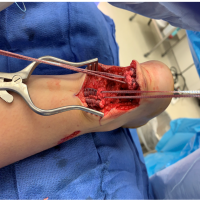[box type=”bio”] What to Learn from this Article?[/box]
Atypical trauma may involve atypical injury. A high index of suspicion with thorough clinical examination and imaging will avoid missing these injuries and subsequent suboptimal results.
Case Report | Volume 6 | Issue 2 | JOCR April-June 2016 | Page 63-65 | Sarang Kasture, Raj Sakamuri DOI: 10.13107/jocr.2250-0685.436
Authors: Sarang Kasture[1], Raj Sakamuri[1]
[1] Department of Trauma and Orthopaedics, Gwynedd hospital Penrhosgarnedd, Bangor, UK. LL57 2PW.
Address of Correspondence
Dr. Sarang Kasture,
Department of Trauma and Orthopaedics, Gwynedd hospital, Penrhosgarnedd, Bangor, UK. LL57 2PW.
E-mail: sarangkasture@gmail.com
Abstract
Introduction: Though isolated traumatic extensor pollicislongus rupture and ulnar collateral ligament rupture of the metacarpophalangeal joint of the thumb are well known injuries, it is rare to have simultaneous bilateral thumb injuries from a single traumatic event. In this article, we report simultaneous bilateral traumatic thumb injury with extensor pollicislongus tendon rupture on one side and ulnar collateral ligament tear on the other side. To the best of our knowledge, such injury has never been reported in the English literature.
Case report: A 48-year-old healthy gentleman sustained simultaneous bilateral thumb injuries after a fall from mountain bike which was initially missed in the emergency department. Both injuries were later treated operatively with an excellent outcome at the end of six months. A peculiar mechanism explained simultaneous injury to both the thumbs.
Conclusion: This unique combination of bilateral simultaneous traumatic thumb injuries is very rare. Further, due to subtle clinical findings and normal radiographs these injuries are more likely to be missed at initial evaluation Emergency physicians should be aware of it as majority of them require operative intervention for satisfactory outcome.
Key words: Extensor indicisproprius, extensor pollicislongus, simultaneous, traumatic, ulnar collateral ligament.
Introduction
Isolated ulnar collateral ligament (UCL) injury of metacarpophalangeal joint (MCPJ) of thumb and extensor pollicislongus (EPL) tendon rupture are well known injuries [1,2]. Due to the distinct mechanism involved, it is indeed rare to have both these injuries occurring simultaneously from a single traumatic event. Furthermore, both injuries pose a diagnostic challenge in acute setting due to subtle clinical signs and normal radiographs. In this article, we report a rare case of simultaneous bilateral thumb injuries after fall from mountain bike, with ulnar collateral ligament rupture of MCPJ of thumb on one side and the extensor pollicislongus rupture on the other side. We believe, this unique combination of injury not reported previously can be explained by a peculiar sequence of events during the fall.
Case Report
A 48-year-old fit and healthy gentleman fell from a mountain bike following a sudden deceleration impact against a tree. He confirmed landing on the left wrist first and sustained injury to both the thumbs at the same time. He attended the emergency department immediately but the injuries were missed due to significant swelling and pain which made clinical examination difficult. As the radiographs revealed no bony injury he was referred to the hand clinic. He presented with pain and swelling of both the thumbs with painful grip on the right and inability to extend the thumb on the left side. Clinically, there was tenderness along the ulnar aspect of the MCPJ of the right thumb and positive stress test for UCL injury. This was confirmed by stress radiographs of the MCPJ joint of the thumb. The ultra sound scan confirmed complete rupture of UCL at insertion with Stener’s lesion. On the left side, he was unable to extend the interphalangeal joint of the thumb actively. The ultrasound scan confirmed rupture of EPL with the distal stump of the tendon located just distal to the extensor retinaculum. He underwent sequential exploration of both the thumbs in one anaesthetic. On the right side, complete rupture of UCL at the insertion with adductor pollicisaponeurosis interposed (Stener’s lesion) and rupture of dorso-ulnar capsule of MPJ was noted. The capsule was repaired with absorbable sutures and the ruptured UCL was repaired with absorbable anchor suture (Fig 1). On the left side, the distal stump of the EPL tendon was located just distal to the extensor retinaculum (Fig. 2) The proximal stump of EPL could not be located as it had probably retracted deep in the forearm. Hence, EIP tendon was transferred to EPL (Fig. 3). Right thumb was immobilised for six weeks and mobilised thereafter. The left thumb was mobilised after two weeks in a custom made thermoplastic dynamic splint. He was followed up at six weeks, three months, five months and one year after surgery. At the end of five months, he regained full range of movements of both the thumbs and satisfactory grip strength as measured with Jamar Dynamometer.
Discussion
EPL tendon rupture is most commonly seen in patients with rheumatoid arthritis [3]. In non-rheumatoid patients, it may be due to high energy direct trauma, associated with fractures or secondary to internal fixation implants used to stabilise the fractures. It has also been reported in sports persons due to repetitive motion strain [4]. The most common mechanism of injury in traumatic EPL rupture is either a direct closed injury to the wrist or a hyperextension injury of the wrist or rarely a rotational injury causing EPL tendon rupture at the musculotendinous junction [1]. Indirect injury can occur due to stretching force applied to a contracting muscle [5]. A recent study also attributes impaction of the base of third metacarpal against the tendon at the Lister’s tubercle during hyperextension [6]. Restoration of the thumb extension with extensor indicisproprius (EIP) transfer has been reported with good results [7]. Unlike EPL rupture, the UCL injury of the thumb is usually due to acute trauma or repetitive trauma to the thumb. Skier’s thumb usually suggests an acute injury while gamekeepers thumb a chronic injury. The mechanism of injury is excessive valgus strain applied to the metacarpophalangeal joint of the thumb [2,8]. Ultrasound can differentiate Stener’s lesion from simple avulsions [9]. Also, majority of patients with complete rupture and Stener’ lesion will fail to heal with conservative treatment [10]. The patient presented in this case report was non rheumatoid and denied pain or injury to either hand before the fall. Simultaneous injury to both thumbs can be explained by a peculiar mechanism of injury. At the time of impact, fall on the extended left wrist resulted in EPL rupture on that side, while continuing to hold on to the handle bar of the push bike at the time of impact resulted in valgus stress on the MCP joint of the right thumb leading to UCL rupture akin to skiers injury due to pole handle. We believe this mechanism of injury can also cause other thumb injuries and the examining clinician should we aware of it. Though, we understand that it is very difficult to predict the mode of injury, we believe that this is atypical trauma as two distinct mechanisms have caused two different injuries in both thumbs occurring from a single event.
The rehabilitation after simultaneous repair in such cases is challenging as both require different physiotherapy regimes and close monitoring to assess the progress. To achieve best results, the patient needs to understand and comply with the rigorous rehabilitation protocol and should be counselled preoperatively about it. Besides, as in this case, these injuries are more likely to be missed at the initial examination due to subtle clinical findings and normal radiographs. The emergency physician should be well aware of the possibility of these injuries and have a low threshold to investigate them as majority of them subsequently require surgical intervention. The patient should be counselled about the difference in the rehabilitation regimens for both the injuries and the need to adhere to it. These diverse regimens on each side after the surgery can make rehabilitation challenging and can subsequently lead to sub-optimal result when compared to isolated injuries. Finally, each injury should be treated on its own merit and principles remain similar to isolated injuries.
Conclusion
This case report presents an unusual pattern of bilateral thumb injury sustained after a single atypical traumatic event. It also emphasises the need to have low threshold to evaluate these injuries as they are likely to be missed in initial evaluation. Rehabilitation in these diverse injuries is challenging but proper patient counselling and compliance can yield satisfactory functional outcome.
Clinical Message
This report highlights a rare case of bilateral simultaneous thumb injury after an atypical trauma which was initially missed in the emergency department. The emergency physicians should have a low threshold to investigate such injuries further or arrange early referral to the specialist as majority require surgical intervention. The rehabilitation after surgery is challenging and patient needs to be counselled pre-operatively to achieve satisfactory outcome.
References
1. Milch E, Epstein MD. Traumatic rupture of the extensor pollicislongustendon.AnnPlast Surg. 1987;19(5):460-2.
2. Tsiouri C, Hayton MJ, Baratz M. Injury to the ulnar collateral ligament of the thumb. Hand (N Y) 2009;4(1):12-8.
3. Leslie BM. Rheumatoid extensor tendon ruptures. Hand Clin. 1989;5:191-202.
4. Rada EM, Shridharani SM, Lifchez SD Spontaneous atraumatic extensor pollicislongus rupture in the non rheumatoid population. Eplasty 2013:13:e11.
5. Takami H, Takahashi S, Ando M, Suzuki K. Traumaticrupture of the extensortendons at the musculotendinousjunction.J Hand Surg Am. 1995;20(3):474-7.
6. Ferreres A, Llusá M, García-Elías M, Lluch A. A possible mechanism of direct injury to the EPL tendon at Lister’s tubercle during falls with the wrist fully extended. J Hand SurgEur 2008;33(2):149-51.
7. Figl M, Mayer M, Lederer S, Bogner R, Leixnering M. Extensor pollicislongus rupture after distal radius fracture: results of reconstruction by transposition of the extensor indicis tendon and postoperative dynamic splinting Wien KlinWochenschr 2011;123(15-16):485-7.
8. Palmer AK, Louis DS. Assessing ulnar instability of the metacarpophalangeal joint of the thumb. J Hand Surg [Am]. 1978;3(6):542–6.
9. Ebrahim FS, De Maeseneer M, Jager T. US diagnosis of UCL tears of the thumb and Stener lesions: technique, pattern-based approach, and differential diagnosis. Radiographics 2006;26 (4):1007–20.
10. Stener B. Displacement of the ruptures ulnar collateral ligament of the metacarpophalangeal joint of the thumb. J Bone Joint Surg Br. 1962;44-B:869–79.
| How to Cite This Article: Kasture S, Sakamuri R. Bilateral Simultaneous Traumatic Thumb Injuries – Extensor Pollicis Longus Rupture On One Side And Ulnar Collateral Ligament On The Other. Case Report. Journal of Orthopaedic Case Reports 2016 April – June;6(2): 63-65. Available from: https://www.jocr.co.in/wp/2016/04/01/2250-0685-436-fulltext/ |
[Full Text HTML] [Full Text PDF] [XML]
[rate_this_page]
Dear Reader, We are very excited about New Features in JOCR. Please do let us know what you think by Clicking on the Sliding “Feedback Form” button on the <<< left of the page or sending a mail to us at editor.jocr@gmail.com








